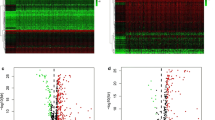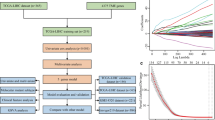Abstract
Background
Hepatocellular carcinoma (HCC) ranks the fourth in terms of cancer-related mortality globally. Herein, in this research, we attempted to develop a novel immune-related gene signature that could predict survival and efficacy of immunotherapy for HCC patients.
Methods
The transcriptomic and clinical data of HCC samples were downloaded from The Cancer Genome Atlas (TCGA) and GSE14520 datasets, followed by acquiring immune-related genes from the ImmPort database. Afterwards, an immune-related gene-based prognostic index (IRGPI) was constructed using the Least Absolute Shrinkage and Selection Operator (LASSO) regression model. Kaplan–Meier survival curves as well as time-dependent receiver operating characteristic (ROC) curve were performed to evaluate its predictive capability. Besides, both univariate and multivariate analyses on overall survival for the IRGPI and multiple clinicopathologic factors were carried out, followed by the construction of a nomogram. Finally, we explored the possible correlation of IRGPI with immune cell infiltration or immunotherapy efficacy.
Results
Analysis of 365 HCC samples identified 11 differentially expressed immune-related genes, which were selected to establish the IRGPI. Notably, it can predict the survival of HCC patients more accurately than published biomarkers. Furthermore, IRGPI can predict the infiltration of immune cells in the tumor microenvironment of HCC, as well as the response of immunotherapy.
Conclusion
Collectively, the currently established IRGPI can accurately predict survival, reflect the immune microenvironment, and predict the efficacy of immunotherapy among HCC patients.






Similar content being viewed by others
Abbreviations
- ALT:
-
Alanine transferase
- AUC:
-
Area under curve
- BP:
-
Biological process
- CC:
-
Cellular component
- CIs:
-
Confidence intervals
- DAVID:
-
Database for Annotation, Visualization, and Integrated Discovery
- DEG:
-
Differentially expressed gene
- DEIRG:
-
Differentially expressed immune-related gene
- FDR:
-
False discovery rate
- GEO:
-
Gene Expression Omnibus
- GO:
-
Gene Ontology
- HCC:
-
Hepatocellular carcinoma
- HRs:
-
Hazard ratios
- ICI:
-
Immune checkpoint inhibitor
- ImmPort:
-
Immunology Database and Analysis Portal
- IPS:
-
Immunophenoscore
- IRG:
-
Immune-related gene
- IRGPI:
-
Immune-related gene-based prognostic index
- KEGG:
-
Kyoto Encyclopedia of Genes and Genomes
- K-M:
-
Kaplan–Meier
- LASSO:
-
Least Absolute Shrinkage and Selection Operator
- MAF:
-
Mutation Annotation Format
- MF:
-
Molecular function
- MX:
-
Unknown M stage
- NX:
-
Unknown N stage
- OS:
-
Overall survival
- ROC:
-
Receiver operating characteristic
- TCGA:
-
The Cancer Genome Atlas
- TCIA:
-
The Cancer Immunome Atlas
- TIME:
-
Tumor immune microenvironment
- TMB:
-
Tumor mutation burden
- TX:
-
Unknown T stage
References
Bray F, Ferlay J, Soerjomataram I et al (2018) Global cancer statistics 2018: GLOBOCAN estimates of incidence and mortality worldwide for 36 cancers in 185 countries. CA Cancer J Clin 68:394–424. https://doi.org/10.3322/caac.21492
Llovet JM, Zucman-Rossi J, Pikarsky E et al (2016) Hepatocellular carcinoma. Nat Rev Dis Prim 2:16018. https://doi.org/10.1038/nrdp.2016.18
Allemani C, Matsuda T, Di Carlo V et al (2018) Global surveillance of trends in cancer survival 2000–14 (CONCORD-3): analysis of individual records for 37 513 025 patients diagnosed with one of 18 cancers from 322 population-based registries in 71 countries. The Lancet 391:1023–1075. https://doi.org/10.1016/S0140-6736(17)33326-3
Fujiwara N, Friedman SL, Goossens N, Hoshida Y (2018) Risk factors and prevention of hepatocellular carcinoma in the era of precision medicine. J Hepatol 68:526–549. https://doi.org/10.1016/j.jhep.2017.09.016
Famularo S, Di Sandro S, Giani A et al (2018) Recurrence patterns after anatomic or parenchyma-sparing liver resection for hepatocarcinoma in a western population of cirrhotic patients. Ann Surg Oncol 25:3974–3981. https://doi.org/10.1245/s10434-018-6730-0
Llovet JM, Montal R, Sia D, Finn RS (2018) Molecular therapies and precision medicine for hepatocellular carcinoma. Nat Rev Clin Oncol 15:599–616. https://doi.org/10.1038/s41571-018-0073-4
Iñarrairaegui M, Melero I, Sangro B (2018) Immunotherapy of hepatocellular carcinoma: facts and hopes. Clin Cancer Res 24:1518–1524. https://doi.org/10.1158/1078-0432.CCR-17-0289
Heinrich B, Czauderna C, Marquardt JU (2018) Immunotherapy of hepatocellular carcinoma. Oncol Res Treat 41:292–297. https://doi.org/10.1159/000488916
Galle PR, Forner A, Llovet JM et al (2018) EASL clinical practice guidelines: management of hepatocellular carcinoma. J Hepatol 69:182–236. https://doi.org/10.1016/j.jhep.2018.03.019
Taube JM, Galon J, Sholl LM et al (2018) Implications of the tumor immune microenvironment for staging and therapeutics. Mod Pathol 31:214–234. https://doi.org/10.1038/modpathol.2017.156
Xu WH, Xu Y, Wang J et al (2019) Prognostic value and immune infiltration of novel signatures in clear cell renal cell carcinoma microenvironment. Aging 11:6999–7020. https://doi.org/10.18632/aging.102233
Long J, Wang A, Bai Y et al (2019) Development and validation of a TP53-associated immune prognostic model for hepatocellular carcinoma. EBioMedicine 42:363–374. https://doi.org/10.1016/j.ebiom.2019.03.022
Pan L, Fang J, Chen MY et al (2020) Promising key genes associated with tumor microenvironments and prognosis of hepatocellular carcinoma. World J Gastroenterol 26:789–803. https://doi.org/10.3748/wjg.v26.i8.789
Zhang FP, Huang YP, Luo WX et al (2020) Construction of a risk score prognosis model based on hepatocellular carcinoma microenvironment. World J Gastroenterol 26:134–153. https://doi.org/10.3748/wjg.v26.i2.134
Weinstein JN, Collisson EA, Mills GB et al (2013) The cancer genome atlas pan-cancer analysis project. Nat Genet 45:1113–1120. https://doi.org/10.1038/ng.2764
Wang Y, Gao B, Tan PY et al (2019) Genome-wide CRISPR knockout screens identify NCAPG as an essential oncogene for hepatocellular carcinoma tumor growth. FASEB J: Off Publ Fed Am Soc Exp Biol 33:8759–8770. https://doi.org/10.1096/fj.201802213RR
Bhattacharya S, Andorf S, Gomes L et al (2014) ImmPort: disseminating data to the public for the future of immunology. Immunol Res 58:234–239. https://doi.org/10.1007/s12026-014-8516-1
Ritchie ME, Phipson B, Wu D et al (2015) Limma powers differential expression analyses for RNA-sequencing and microarray studies. Nucleic Acids Res 43:e47. https://doi.org/10.1093/nar/gkv007
Ginestet C (2011) ggplot2: elegant graphics for data analysis. J Royal Stat Soc: Series A (Stat Soc) 174:245–246. https://doi.org/10.1111/j.1467-985x.2010.00676_9.x
Huang DW, Sherman BT, Lempicki RA (2009) Systematic and integrative analysis of large gene lists using DAVID bioinformatics resources. Nat Protoc 4:44–57. https://doi.org/10.1038/nprot.2008.211
Ogata H, Goto S, Sato K et al (2000) KEGG: kyoto encyclopedia of genes and genomes. Nucleic Acids Res 28:27–30. https://doi.org/10.1093/nar/27.1.29
Gene Ontology Consortium (2004) The Gene Ontology (GO) database and informatics resource. Nucleic Acids Res 32:D258–D261. https://doi.org/10.1093/nar/gkh036
Friedman J, Hastie T, Tibshirani R (2010) Regularization paths for generalized linear models via coordinate descent. J Stat Softw 33:1–22. https://doi.org/10.18637/jss.v033.i01
Rhodes DR, Yu J, Shanker K et al (2004) ONCOMINE: a cancer microarray database and integrated data-mining platform. Neoplasia 6:1–6. https://doi.org/10.1016/s1476-5586(04)80047-2
Therneau TM (2015) A package for survival analysis in S. Version 2.38. CRAN website—https://cran.r-project.org/package=survival
Heagerty PJ, Lumley T, Pepe MS (2000) Time-dependent ROC curves for censored survival data and a diagnostic marker. Biometrics 56:337–344. https://doi.org/10.1111/j.0006-341X.2000.00337.x
Harrell Jr FE (2016) rms: Regression Modeling Strategies. R package version 5.0–0. CRAN
Newman AM, Liu CL, Green MR et al (2015) Robust enumeration of cell subsets from tissue expression profiles. Nat Methods 12:453–457. https://doi.org/10.1038/nmeth.3337
Charoentong P, Finotello F, Angelova M et al (2017) Pan-cancer immunogenomic analyses reveal genotype-immunophenotype relationships and predictors of response to checkpoint blockade. Cell Reports 18:248–262. https://doi.org/10.1016/j.celrep.2016.12.019
Liu L, Bai X, Wang J et al (2019) Combination of TMB and CNA stratifies prognostic and predictive responses to immunotherapy across metastatic cancer. Clin Cancer Res 25:7413–7423. https://doi.org/10.1158/1078-0432.CCR-19-0558
Jensen MA, Ferretti V, Grossman RL, Staudt LM (2017) The NCI genomic data commons as an engine for precision medicine. Blood 130:453–459. https://doi.org/10.1182/blood-2017-03-735654
Mayakonda A, Lin DC, Assenov Y et al (2018) Maftools: efficient and comprehensive analysis of somatic variants in cancer. Genome Res 28:1747–1756. https://doi.org/10.1101/gr.239244.118
Yang S, Wu Y, Deng Y et al (2019) Identification of a prognostic immune signature for cervical cancer to predict survival and response to immune checkpoint inhibitors. OncoImmunology 8:e1659094. https://doi.org/10.1080/2162402X.2019.1659094
Berraondo P, Minute L, Ajona D et al (2016) Innate immune mediators in cancer: between defense and resistance. Immunol Rev 274:290–306. https://doi.org/10.1111/imr.12464
Elola MT, Ferragut F, Méndez-Huergo SP et al (2018) Galectins: multitask signaling molecules linking fibroblast, endothelial and immune cell programs in the tumor microenvironment. Cell Immunol 333:34–45. https://doi.org/10.1016/j.cellimm.2018.03.008
Gardner A, Ruffell B (2016) Dendritic cells and cancer immunity. Trends Immunol 37:855–865. https://doi.org/10.1016/j.it.2016.09.006
Cariani E, Missale G (2019) Immune landscape of hepatocellular carcinoma microenvironment: implications for prognosis and therapeutic applications. Liver International 39:1608–1621. https://doi.org/10.1111/liv.14192
Banerjee K, Kumar S, Ross KA et al (2018) Emerging trends in the immunotherapy of pancreatic cancer. Cancer Lett 417:35–46. https://doi.org/10.1016/j.canlet.2017.12.012
Sanmamed MF, Chen L (2018) A paradigm shift in cancer immunotherapy: from enhancement to normalization. Cell 175:313–326. https://doi.org/10.1016/j.cell.2018.09.035
Jiang Y, Han QJ, Zhang J (2019) Hepatocellular carcinoma: mechanisms of progression and immunotherapy. World J Gastroenterol 25:3151–3167. https://doi.org/10.3748/wjg.v25.i25.3151
Zhao QJ, Zhang J, Xu L, Liu FF (2018) Identification of a five-long non-coding RNA signature to improve the prognosis prediction for patients with hepatocellular carcinoma. World J Gastroenterol 24:3426–3439. https://doi.org/10.3748/wjg.v24.i30.3426
Bing Z, Tian J, Zhang J et al (2016) An integrative model of miRNA and mRNA expression signature for patients of breast invasive carcinoma with radiotherapy prognosis. Cancer Biotherapy Radiopharm 31:253–260. https://doi.org/10.1089/cbr.2016.2059
Jiang X, Hao Y (2018) Analysis of expression profile data identifies key genes and pathways in hepatocellular carcinoma. Oncology Letters 15:2625–2630. https://doi.org/10.3892/ol.2017.7534
Cheng J, Xie HY, Xu X et al (2011) NDRG1 as a biomarker for metastasis, recurrence and of poor prognosis in hepatocellular carcinoma. Cancer Lett 310:35–45. https://doi.org/10.1016/j.canlet.2011.06.001
Lian YF, Huang YL, Zhang YJ et al (2019) CacYBP enhances cytoplasmic retention of p27Kip1 to promote hepatocellular carcinoma progression in the absence of RNF41 mediated degradation. Theranostics 9:8392–8408. https://doi.org/10.7150/thno.36838
Liu M, Li Y, Chen L et al (2014) Allele-specific imbalance of oxidative stress-induced growth inhibitor 1 associates with progression of hepatocellular carcinoma. Gastroenterology 146:1084–1096. https://doi.org/10.1053/j.gastro.2013.12.041
Lv J, Zhang S, Wu H et al (2020) Deubiquitinase PSMD14 enhances hepatocellular carcinoma growth and metastasis by stabilizing GRB2. Cancer Lett 469:22–34. https://doi.org/10.1016/j.canlet.2019.10.025
Matsumoto H, Thike AA, Li H et al (2016) Increased CD4 and CD8-positive T cell infiltrate signifies good prognosis in a subset of triple-negative breast cancer. Breast Cancer Res Treat 156:237–247. https://doi.org/10.1007/s10549-016-3743-x
Yao RR, Li JH, Zhang R et al (2018) M2-polarized tumor-associated macrophages facilitated migration and epithelial-mesenchymal transition of HCC cells via the TLR4/STAT3 signaling pathway. World J Surg Oncol 16:9. https://doi.org/10.1186/s12957-018-1312-y
Choi C, Yoo GS, Cho WK, Park HC (2019) Optimizing radiotherapy with immune checkpoint blockade in hepatocellular carcinoma. World J Gastroenterol 25:2416–2429. https://doi.org/10.3748/wjg.v25.i20.2416
Longo V, Brunetti O, Gnoni A et al (2019) Emerging role of immune checkpoint inhibitors in hepatocellular carcinoma. Medicina (Lithuania) 55:698. https://doi.org/10.3390/medicina55100698
Ying HQ, Deng QW, He BS et al (2014) The prognostic value of preoperative NLR, d-NLR, PLR and LMR for predicting clinical outcome in surgical colorectal cancer patients. Med Oncol 31:305. https://doi.org/10.1007/s12032-014-0305-0
Zhang G, Wu Y, Zhang J et al (2018) Nomograms for predicting long-term overall survival and disease-specific survival of patients with clear cell renal cell carcinoma. OncoTarget Ther 11:5535–5544. https://doi.org/10.2147/OTT.S171881
Funding
This work was supported by grants from the National Natural Science Foundation of China (Grant No. 81673460) and Science and Technology Department of Sichuan Province (Grant No. 2020JDTD0022).
Author information
Authors and Affiliations
Contributions
YD, WQ and DW conceived the study; YD, WQ, KL, XL and DW designed the experiments; YD performed the experiments; YD and WQ wrote the manuscript; KL, YG, XL and DW edited the manuscript; and all authors read and gave final approval to submit the manuscript.
Corresponding authors
Ethics declarations
Competing interests
The authors declare that they have no competing interests.
Availability of data and material
The datasets used during the current study are available from the corresponding author on reasonable request.
Additional information
Publisher's Note
Springer Nature remains neutral with regard to jurisdictional claims in published maps and institutional affiliations.
Electronic supplementary material
Below is the link to the electronic supplementary material.
Rights and permissions
About this article
Cite this article
Dai, Y., Qiang, W., Lin, K. et al. An immune-related gene signature for predicting survival and immunotherapy efficacy in hepatocellular carcinoma. Cancer Immunol Immunother 70, 967–979 (2021). https://doi.org/10.1007/s00262-020-02743-0
Received:
Accepted:
Published:
Issue Date:
DOI: https://doi.org/10.1007/s00262-020-02743-0




